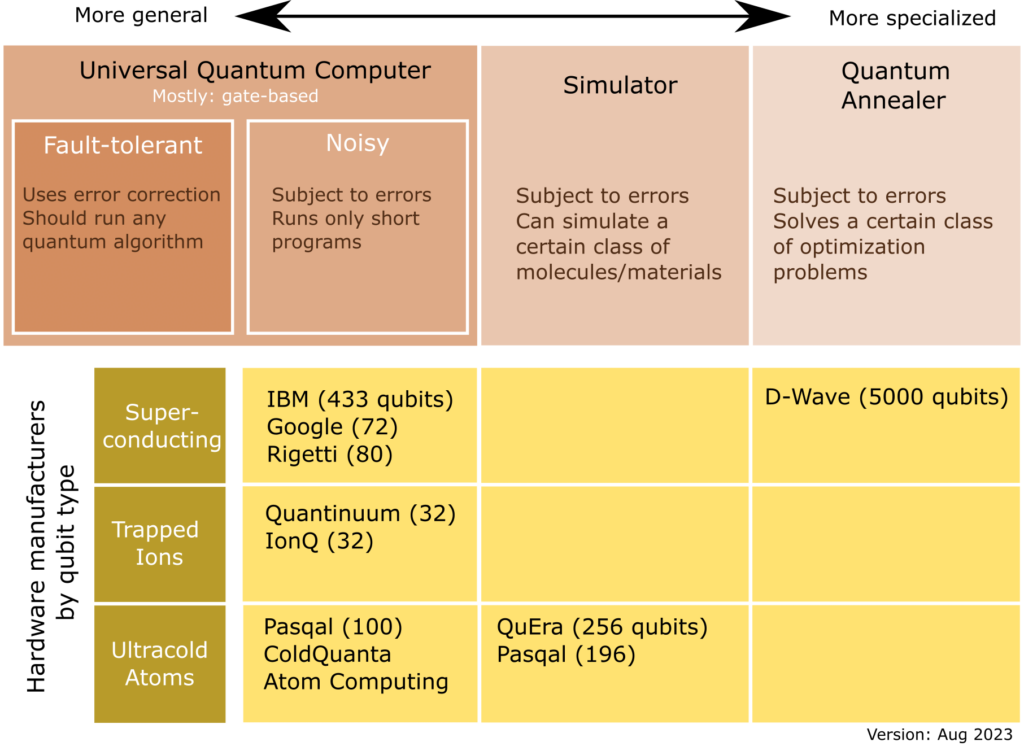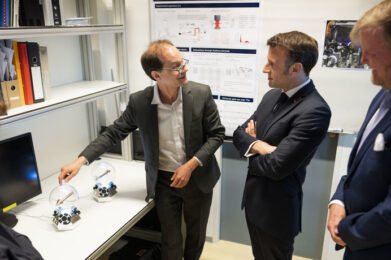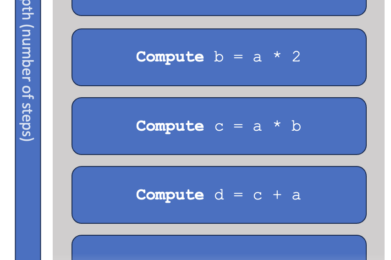The professional’s guide to Quantum Technology
- Preface: Why this guide?
- Part 1 – The background: Why are we so enthusiastic about Quantum Technology?
- Part 2 – The applications: What problems will we solve with Quantum Computers?
- Part 3 – The developments: Searching for a killer application, with a closer look at artificial fertilizer
- Part 4 – The applications of Quantum Networks
- Part 5 – Timelines: When can we expect a useful quantum computer?
- Part 6 – Getting started: What steps should your organization take?
- Part 7 – The hardware: Why you should care about different qubits
- Part 8 – The threat: The impact on cybersecurity
- Part 9 – Scaling up: Why we need error correction
- Further reading: An overview of resources
Part 7 – The hardware: Why you should care about different qubits
If you buy a conventional computer, like a laptop or a server, these devices work kinda well out of the box, right? Joking aside, within classical IT, essentially any product on the market is fairly user-friendly and extremely reliable. You might take the effort to compare specifications like clock speed or memory, and you might be happier with a faster or fancier computer, but for a majority of applications, these computers all function effectively the same. We will see that this is radically different for quantum computers: devices make mistakes, have limited functionalities, and depending on your application, you might like to use a completely different architecture.
In this chapter, we take a high-level business perspective at quantum computing hardware. What should you know when starting your quantum journey?
The figure below shows different types of functionalities that quantum computers can have (top, brown), along with some examples of hardware that is available (below, yellow). This list is by no means complete! It should at best give an impression of the current state of the art. Let us start by taking a closer look at the functionalities.

Our biggest dream is to have a ‘universal quantum computer’. The word ‘universal’ indicates that it is capable of executing any quantum algorithm (or technically: to approximate any algorithm’s output to arbitrary precision). For comparison: your laptop, phone, and even a smartwatch are universal classical computers, making them capable of running any classical application you can think of: spreadsheets, 3D games, data encryption, and so on. Similarly, a proper universal quantum computer is suitable for any quantum application, regardless of whether it is known today or invented in the future.
The definition of ‘universal’ is blind to some details such as memory limitations (it assumes you will never run out of RAM), and omits tedious details about software compatibility (a Playstation game won’t run on an XBox). In our high level overview, such details are unimportant: the main point is that there also exist devices that can not run just any algorithm.
No, there are various computational models that can run any algorithm.
There are different ways to make a ‘universal quantum computer’. The most popular way is to use a gate-based approach, where elementary operations (‘gates’) change the data stored one or two qubits at a time. This perspective is most intuitive for those used to conventional logical circuits (with AND, OR and NOT gates), and most quantum algorithms are presented in this language. Other alternatives include adiabatic computation and measurement-based computation, which can theoretically run any algorithm written for a gate-based computer without issues.
At this moment, gate-based computers are by far the most widespread and appear to be the most popular approach in the race towards a million-qubit quantum computer: by nearly all large tech-companies follow this architecture. There is one important exception: Some photonics startups are working towards measurement-based computing, as this overcomes the challenges in performing ‘entangling’ quantum gates with photons. This guide focuses mostly on gate-based computers.
No matter what architecture or qubit type you pick, our current technology will not allow you to run very long computations. This is due to the inherent imperfections in construction and control of quantum devices. The imperfections cause errors to accumulate during a computation, so that after some number of steps, the result is almost surely corrupted and unusable. For longer computations, it is essential to fix errors on the fly, using so-called error correction (also known as: fault-tolerance).
Today, we are stuck in a so-called NISQ-era, with Noisy Intermediate-Scale Quantum devices. Many are in principle universal, except that they are limited both in the number of qubits, and in the number of steps that can be executed. Companies like IBM, IonQ, Quantinuum and Pasqal all have NISQ computers available to test your own programs on.
Making a universal computer is challenging, and engineers can make special-purpose devices that improve in certain areas (like number of qubits or clock speed) by omitting certain functionalities. In a Quantum Simulator, the computer specialises in simulating a certain class of materials or molecules. The precise capabilities are often captured in a Hamiltonian that specifies which materials qualify. As an example, Harvard-spinoff QuEra has a quantum simulator available over the cloud that mimics a quantum Ising model. Today’s simulators (like QuEra’s) are fairly close to a universal computer (lacking only a few technical ingredients) and are similarly subject to accumulating errors. However, they are not designed to run conventional (gate-based) algorithms.
There might be some confusion in jargon here, as the term ‘quantum simulation’ is also sometimes used when a classical computer tries to mimic the behaviour of a quantum computer. Others use the term ‘emulation’ for such classical approaches.
See also:
Another special-purpose device is the Quantum Annealer, for which the Canadian scale-up D-Wave is especially well known. These special-purpose devices can solve a certain class of optimization problems that goes by the name of QUBO: quadratic unconstrained binary optimization. There is a well-developed theory of mapping various problems into the QUBO formalism, making annealers fairly versatile machines. However, quantum annealers will never be able to take advantage of the various other quantum algorithms out there: even with enough qubits, we don’t see them cracking codes with Shor’s algorithm.
See also:
Different building blocks
There is another question about what material the qubits are actually made of. Scientists have cooked up several competing approaches, such as superconducting materials, photons, or individual atoms, or ions, each with their own strong and weak spots. The methodology or material used to make a physical qubit is often called the qubit implementation, the qubit type, or (we prefer) qubit platform.
For conventional computer electronics, we converged to a single choice of material and broadly a single manufacturing process, based on silicon wafers and lithography. For quantum computers, there is still a fierce race between the different platforms, and it is totally unclear which will eventually be the winner — or whether we will converge to a single winner at all.
There is an interesting story behind the different hardware types, but we won’t delve into that in this non-technical guide (would you otherwise care what material your classical CPU is made of?). However, anyone who wants to test quantum programs on actual hardware should definitely know the details. Interested readers can start here:
Further reading:
- Different types of qubits explained by Sifted.eu
- Different types of qubits at IQC Waterloo
- Different types of qubits on Wikipedia
- A MOOC about different hardware types by TU Delft
It is interesting to note that all these different machines (universal, annealers, simulators) can in principle be built using any type of qubit. If you go back to the figure at the top, you can see that there exist different qubit types with different functionalities. It’s not unthinkable that the empty squares will also be filled, so that we have access to superconducting-based simulators, or annealers that use ultracold atom qubits (or perhaps the authors have missed this!). In fact, we have already seen many academic showcases of superconducting simulators in academic literature.




